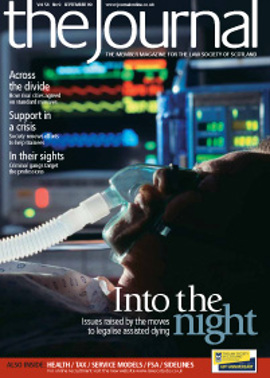Book reviews

Child Abuse, Child Protection and the Law
Alison Cleland’s latest book fills a gap in the child law shelf in the Scottish law library. It is an essential source for anyone working in this demanding and complex field of law whether lawyer, social worker, panel member, child psychiatrist or psychologist, or indeed anyone who works with the most vulnerable children. If you work in the field of child protection, buy this book and read it – and then read it again. It is not an easy read because of its subject, but it is the best book around.
The book is comprehensive. Ms Cleland starts by examining the development of the recognition that child abuse exists, and the gradual development of responses. This section does much to place our current understanding of responses to abuse in the context not just of where we are, but how we got here, as well as looking at what exactly we mean by “child abuse”.
The book then provides a clear analysis of modern child protection, including court processes, Getting It Right For Every Child (GIRFEC), legal and professional duties of the various professions and, joy of joys, a useful explanation of the grounds for referral to the children’s hearing. The interface between child protection, the Data Protection Act and the right of confidentiality often causes difficulty, and while Ms Cleland deals with the statutes and the theory, ultimately it is a practical guide, which is just what those of us at the coal face need, and often find so difficult to get hold of.
Other sections deal with offences against children and young people, the rules of evidence, the needs of child witnesses and an analysis of the interviewing of children and the reliability of their evidence. There is also a review of the consequences for the convicted, from sentencing through to treatment, monitoring and the practicalities of the sex offenders register.
Particularly useful is the examination of social policy developments, support for children, and protective measures. The role of the children’s hearing system, child protection orders and child assessment orders is explored. I found the final section particularly interesting. This is devoted to the vexed question of prevention and cure, and the sheer difficulty of this most harrowing and difficult of topics.
The whole subject of child abuse and the legal response is an emotive one, and fraught with difficulties. Alison Cleland has provided a guide for anyone working in this field that deals clearly and unflinchingly not only with the damage inflicted on children by perpetrators of abuse, but also with the strengths and weaknesses of the systems which we have developed to protect children and to deal with their abusers. It examines the good and bad practices and puts them all in the context of the law and social policy. Thoroughly researched, the wealth of footnotes lead one further to the relevant authorities, statutes and case law. It is a densely written book, but easy to read and I find myself reaching for it over and over again. Since its publication in 2008 the law has already moved on and it is to be hoped that she can be persuaded to produce the second edition soon.
Immigration Law and Practice: 4th edition
Abandoning the looseleaf format of the previous edition, we are presented with a hardback volume of 1,346 pages of text, entirely free of any source materials. Although it covers all the essentials, a major focus of the book concerns those who come to work in the UK. There is a long chapter devoted to “EU law and Movement of Free Persons” (as it is rather curiously called), and five more devoted to the points-based system. As the proposed supplement anticipates, it may be that the latter are too closely tied to the wording of the current scheme to have lasting value. However, the introduction is useful and accurately anticipates some of the problems with the scheme, including the one that led Mrs Ann Gloag and the First Minister to intervene in April on behalf of an immigrant who had fallen foul of its inflexibility.
As in previous editions, there is a good deal of opinion here in which the experience of the authors is apparent. Their humane good sense will make this book a necessary stop where thorough research of a point is required.
This is, however, a book entirely focused on England; Scotland does not occur in the index or in the treatment of court proceedings. There is no treatment of the issue of whether a decision of the tribunal is made in Scotland or England. Common law jurisdictional issues between Scotland and England are dealt with under the heading “Burden of Proof” in the chapter on evidence and proof. This is, of course, not to say that the book is not useful, given that most of the law in this area comes from south of the border.
Inevitably, the enormity of the task has weighed rather heavily on those concerned. Despite the excellent example of the Clayton & Tomlinson “all cases” table, there are three tables of cases – “Table of Cases”, “Before ECJ”, and “Before ECHR”. All pages of these three tables are headed “Table of Cases”. Not surprisingly, this has confused even the compiler of the lists, with the result that some citations of, for example, the Bensaid case appear in the third table, while others occur in the first.
More substantively, the UN Convention on the Rights of the Child does not feature in the section on children, despite the UK having in September 2008 lifted reservations relating to immigration and children in custody with adults. Paragraph 1.14 is out of date in this regard. Nor does it occur in the treatment of article 8, despite the June 2008 Grand Chamber decision of the ECtHR in Maslov v Austria, citing the article that makes the best interests of the child a primary consideration in all actions concerning children undertaken by courts of law or administrative authorities.
Such carping aside, those engaged in this field will find this book largely up to date and authoritative.
Licensing and Gambling Law in Scotland: A Practical Guide
I must congratulate Stephen McGowan for even attempting such a thorough review of the Licensing (Scotland) Act 2005 and its current range of regulations (already added to and no doubt to be further extended in the future). He has combined a review of the many-headed licensing hydra with an overview of the even more complex Gambling Act 2005, its regulations and most of the day-to-day information that those needing help and guidance will easily relate to.
The work sets out, in a clear concise way, who does what and why, what the licensing boards’ responsibilities and powers are, and likewise what their role as a licensing authority under the gambling legislation is. The latter is an area where very few of us dare to go and not one which, I defy anyone to say, they fully understand. The book gives a real flavour of what to be aware of, and not least, where to seek further information.
Sensibly, this book does not seek to provide all the answers, as that would be an almost impossible task and run to many hundreds, if not thousands, of pages, but it certainly provides a route map to finding that which may be important to an adviser and indeed to their clients. Half the battle in life is knowing what to look for and where to look for information, and I believe this book admirably achieves this.
I enjoyed Mr McGowan’s little anecdotes, and no doubt others will too. Whilst I do not always agree with his conclusions, that is only fair and reasonable, as many lawyers will have their own interpretation of what the law is. That is why lawyers are there, to advise and interpret.
What strikes me is that this is an invaluable tool for those who occasionally, and indeed for those who more than occasionally, practise in these ever more complex topics. The book’s well structured, easy-to-follow index neatly splits as between liquor, gambling and other matters. Having a list of Scottish licensing boards and their contact details, a list of current statutory instruments, together with much of the law affecting licensed premises all in one place will, I also suspect, be a very useful tool to many, not only as advisers but as operators.
I only noticed one small error in my first read of the text and that only in a case name. Given the complexity of the related legislation, that is quite an achievement.
This is a book that will inevitably grow and evolve, not least as case law under the new Licensing Act evolves. There will be much debate and interpretation of the Act and regulations, and indeed I envisage the section on licensing board policies being much extended. Licensing board polices (which will have to be reviewed by November next year) are an integral part of the new licensing regimen, and will have a major impact on the licensed trade, yet much of the policy content, not least as regards children and young persons, is currently being overlooked by those who have to have regard to their practical and legal implementation.
I am sure Mr McGowan will look forward to producing the second and third editions as time moves on, and I wish him further success in his endeavours, as there is no doubt in my mind that this book should be found in the library of those who do any work at all in these areas of the law; and for those who do much, it is in my personal view an excellent aide-mémoire.
I note he takes a marvellous quote from James Purves SSC in 1896. I have a copy of Purves’ eighth edition, and in its preface when talking about the Licensing (Scotland) Act 1957 it says: “It is felt that those responsible for drafting the new Act are to be congratulated on the skill with which they have accommodated their difficult task”.
I would pass that compliment on to Stephen for his book, and at the same time might I say thanks to those who, like the draftsmen of the 1976 Act, have unwittingly provided many of those who will read and enjoy this book with much sustenance in the years to come.
In this issue
- Internet use in the workplace: a digital dilemma?
- Mental Welfare Commission for Scotland under threat
- Tricky choice over Liechtenstein assets
- Cost and benefit
- Curators: the vital link
- Solicitor advocates: the future (part 2)
- Trainee recruitment: dialogue continues
- What sort of life?
- Registers page
- Foot on the ladder
- Recovery vehicle
- Your say
- Lawyers in their sights
- West Bank: a response
- Fairness guide to success
- Facebook debate pulls them in
- Law reform update
- Ahead of the game
- Ask Ash
- A club you don't want to join
- Stress busters
- Into the ether we go!
- Breaking up is hard to do
- Definitive view
- Right that doesn't pale
- Mutu point
- Once bitten, twice shy
- Scottish Solicitors' Discipline Tribunal
- Website review
- Book reviews
- FSA starts to fight back
- For a good clause






